I'm not using storyboard and I'm doing everything programmatically.
So my problem is that when try to run the app on my phone (This does not happen when I use the simulator in Xcode), and when I use the following method...
override func tableView(_ tableView: UITableView, didSelectRowAt indexPath: IndexPath) {
let destinationVC = ThirdViewController()
destinationVC.selectedExercise = exercises![indexPath.row]
self.navigationController?.pushViewController(destinationVC, animated: true)
}
...to transition from a UITableView to a UIView, the contents of the View transition normally, but the background freezes for a second before transitioning to the UIView.
What's causing this and how can I fix this?
Here is the code for the viewController that I'm transitioning to.
import UIKit
import RealmSwift
class ThirdViewController: UIViewController, UITextViewDelegate {
let realm = try! Realm()
var stats : Results<WeightSetsReps>?
var weightTextField = UITextField()
var weightLabel = UILabel()
var notesTextView = UITextView()
var repsTextField = UITextField()
var repsLabel = UILabel()
var timerImage = UIImageView()
var nextSet = UIButton()
var nextExcersise = UIButton()
var selectedExercise : Exercises? {
didSet{
loadWsr()
}
}
//MARK: - ViewDidLoad()
override func viewDidLoad() {
super.viewDidLoad()
notesTextView.delegate = self
timeClock()
navConAcc()
labelConfig()
setTextFieldConstraints()
setImageViewConstraints()
setTextViewConstraints()
setButtonConstraints()
let tap = UITapGestureRecognizer(target: self, action: #selector(dismissKeyboard))
view.addGestureRecognizer(tap)
}
//MARK: - UILabel
func labelConfig(){
weightTextField.placeholder = "Total weight..."
weightTextField.layer.borderWidth = 1
weightTextField.backgroundColor = .white
weightTextField.layer.cornerRadius = 25
weightTextField.layer.borderColor = UIColor.lightGray.cgColor
weightLabel.text = " Weight (lbs): "
weightLabel.textColor = .black
weightTextField.leftView = weightLabel
weightTextField.leftViewMode = .always
repsTextField.placeholder = "Number of Reps..."
repsTextField.layer.borderWidth = 1
repsTextField.backgroundColor = .white
repsTextField.layer.cornerRadius = 25
repsTextField.layer.borderColor = UIColor.lightGray.cgColor
repsLabel.text = " Repetitions: "
repsLabel.textColor = .black
notesTextView.layer.borderWidth = 1
notesTextView.backgroundColor = .white
notesTextView.layer.cornerRadius = 25
notesTextView.layer.borderColor = UIColor.lightGray.cgColor
notesTextView.text = " Notes..."
notesTextView.textColor = UIColor.lightGray
notesTextView.returnKeyType = .done
repsTextField.leftView = repsLabel
repsTextField.leftViewMode = .always
nextSet.layer.borderWidth = 1
nextSet.backgroundColor = .white
nextSet.layer.cornerRadius = 25
nextSet.layer.borderColor = UIColor.lightGray.cgColor
nextSet.setTitle("Next Set", for: .normal)
nextSet.setTitleColor(.black, for: .normal)
nextSet.addTarget(self, action: #selector(addNewSet), for: .touchUpInside)
nextExcersise.layer.borderWidth = 1
nextExcersise.backgroundColor = .white
nextExcersise.layer.cornerRadius = 25
nextExcersise.layer.borderColor = UIColor.lightGray.cgColor
nextExcersise.setTitle("Next Exercise", for: .normal)
nextExcersise.setTitleColor(.black, for: .normal)
[weightTextField, repsTextField, notesTextView, nextSet, nextExcersise].forEach{view.addSubview($0)}
}
//MARK: - TextView Delegates
func textViewDidBeginEditing(_ textView: UITextView) {
if textView.text == " Notes..." {
textView.text = ""
textView.textColor = UIColor.black
}
}
func textView(_ textView: UITextView, shouldChangeTextIn range: NSRange, replacementText text: String) -> Bool {
if text == "\n" {
textView.resignFirstResponder()
}
return true
}
func textViewDidEndEditing(_ textView: UITextView) {
if textView.text == ""{
notesTextView.text = " Notes..."
notesTextView.layer.borderColor = UIColor.lightGray.cgColor
}
}
//MARK: - Dismiss Keyboard Function
@objc func dismissKeyboard(){
view.endEditing(true)
}
//MARK: - TextField Constraints
func setTextFieldConstraints(){
weightTextField.anchor(top: view.safeAreaLayoutGuide.topAnchor, leading: view.leadingAnchor, bottom: nil, trailing: view.trailingAnchor,padding: .init(top: 20, left: 40, bottom: 0, right: -40), size: .init(width: 0, height: 50))
repsTextField.anchor(top: weightTextField.bottomAnchor, leading: view.leadingAnchor, bottom: nil, trailing: view.trailingAnchor, padding: .init(top: 30, left: 40, bottom: 0, right: -40) ,size: .init(width: 0, height: 50))
}
//MARK: - UIButton Functions
@objc func addNewSet(){
print("It Works")
}
//MARK: - UIButton Constraints
func setButtonConstraints(){
nextSet.anchor(top: nil, leading: view.leadingAnchor, bottom: view.safeAreaLayoutGuide.bottomAnchor, trailing: nil, padding: .init(top: 0, left: 40, bottom: 0, right: -150), size: .init(width: 120, height: 70))
nextExcersise.anchor(top: nil, leading: nextSet.trailingAnchor, bottom: nextSet.bottomAnchor, trailing: view.trailingAnchor, padding: .init(top: 0, left: 85, bottom: 0, right: -40), size: .init(width: 120, height: 70))
}
//MARK: - ImageView Constraints
func setImageViewConstraints(){
timerImage.anchor(top: repsTextField.bottomAnchor, leading: view.leadingAnchor, bottom: nil, trailing: view.trailingAnchor, padding: .init(top: 40, left: 0, bottom: 0, right: 0), size: .init(width: 100, height: 100))
}
//MARK: - TextView Constraints
func setTextViewConstraints(){
notesTextView.anchor(top: timerImage.bottomAnchor, leading: view.leadingAnchor, bottom: nil, trailing: view.trailingAnchor, padding: .init(top: 40, left: 40, bottom: 0, right: -40), size: .init(width: 100, height: 110))
}
//MARK: - Navigation Bar Setup
func navConAcc(){
navigationItem.title = selectedExercise?.exerciseName
navigationController?.navigationBar.prefersLargeTitles = true
}
//MARK: - Stopwatch
func timeClock(){
let image1 = UIImage(named: "stopwatch")
timerImage = UIImageView(image: image1)
timerImage.contentMode = .scaleAspectFit
self.view.addSubview(timerImage)
}
//MARK: - Load Data
func loadWsr() {
stats = selectedExercise?.wsr.sorted(byKeyPath: "sets", ascending: true)
}
//MARK: - Save Data
func save(wsr : WeightSetsReps){
do {
try realm.write {
realm.add(wsr)
}
} catch {
print("Error saving wsr data \(error)")
}
}
}
extension UIView {
func anchor(top: NSLayoutYAxisAnchor?, leading: NSLayoutXAxisAnchor?, bottom: NSLayoutYAxisAnchor?, trailing: NSLayoutXAxisAnchor?, padding: UIEdgeInsets = .zero, size: CGSize = .zero){
translatesAutoresizingMaskIntoConstraints = false
if let top = top {
topAnchor.constraint(equalTo: top, constant: padding.top).isActive = true
}
if let leading = leading {
leadingAnchor.constraint(equalTo: leading, constant: padding.left).isActive = true
}
if let bottom = bottom {
bottomAnchor.constraint(equalTo: bottom, constant: padding.bottom).isActive = true
}
if let trailing = trailing {
trailingAnchor.constraint(equalTo: trailing, constant: padding.right).isActive = true
}
if size.width != 0 {
widthAnchor.constraint(equalToConstant: size.width).isActive = true
}
if size.height != 0 {
heightAnchor.constraint(equalToConstant: size.height).isActive = true
}
}
}
